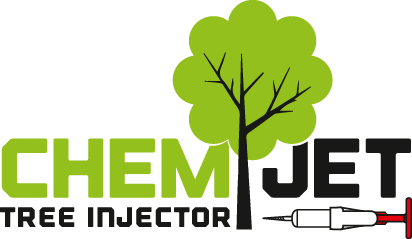Oak Wilt Prevention and Treatment
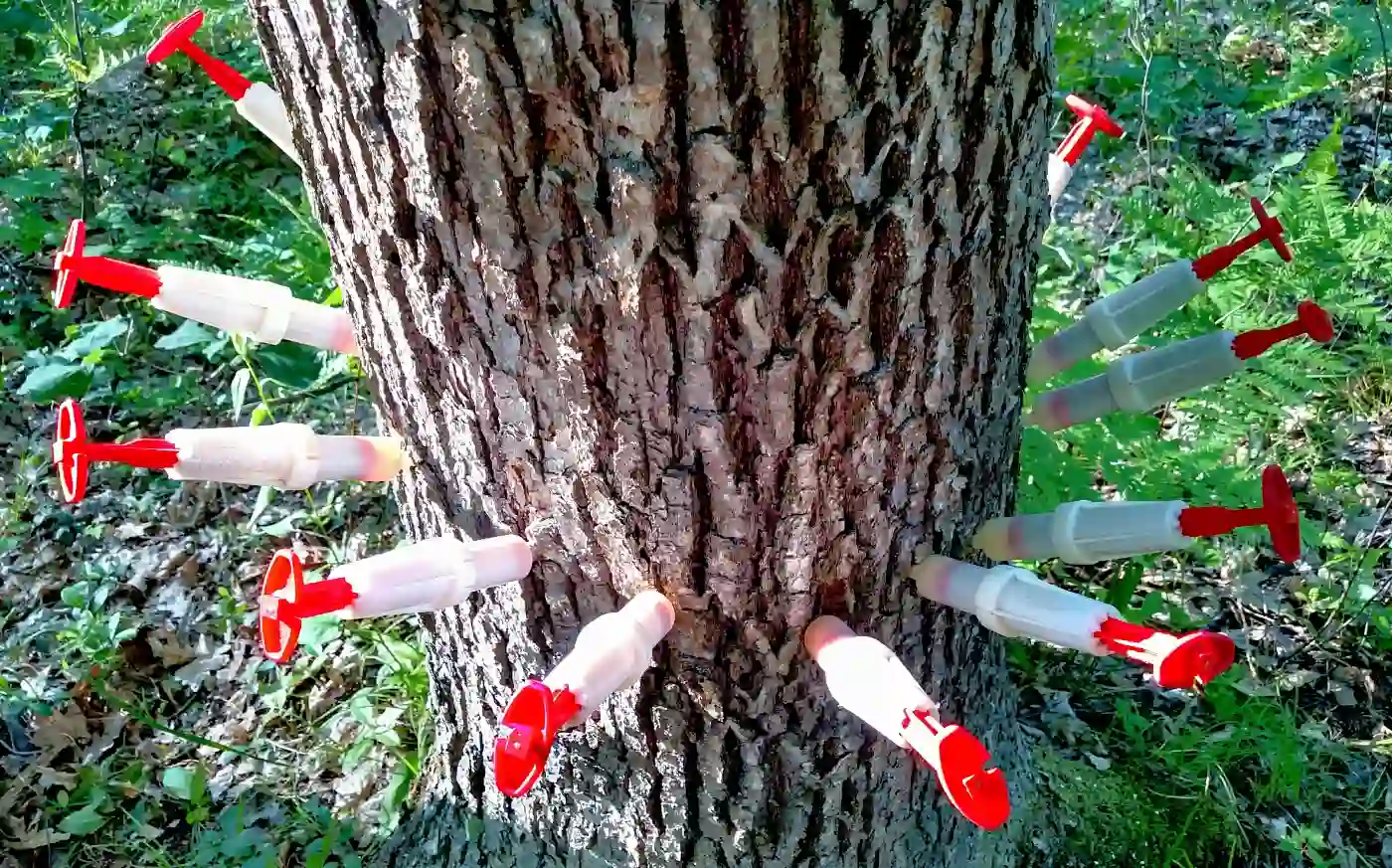
Oak wilt is an aggressive disease that affects several species of oak trees. It is one of the most serious tree diseases in the central and eastern United States, killing many thousands of oaks each year in forests, woodlots, and home landscapes. It is caused by the fungus, Ceratocystis fagacearum, which invades the water conducting tissues (xylem) and induces the tree to clog its own vascular system, preventing the normal flow of water. This causes the foliage to wilt and tree death. Oak wilt can spread from infected trees to healthy trees through root grafts between nearby oaks and by insects that carry spores of the fungus from one tree to another.
Oak species that are particularly susceptible to quick death from oak wilt include: Red Oak, Black Oak, Pin Oak, Burr Oak, Live Oak. Other oak species, including White Oak, are affected to a lesser extent.
Other Treatments and Info
- Oak Wilt Prevention and Treatment
- Save Your Trees from Oak Wilt
- Microinjection to Protect Trees From Oak Wilt
- Emerald Ash Borer Treatment
- Dutch Elm Disease
- Pine Bark Beetle Injection Treatment
- Sudden Oak Death
- Hemlock Woolly Adelgid Treatment
- Asian Longhorned Beetle Treatment
- Caterpillars, Beetles, Borers
- Orchard Crops Treatment
- Plugs for Tree Injection Holes
- Chemjet Tips and Ideas
Distribution of Oak Wilt Disease
2016 map shows the distribution oak wilt disease over the central and eastern US. Since 2016 oak wilt has spread to many additional areas of US.
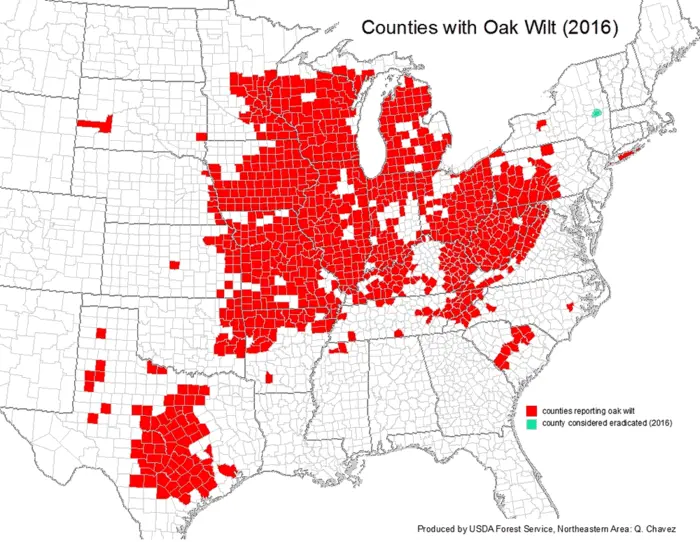
Disease Cycle of Oak Wilt
The oak wilt fungus moves from tree to tree in two ways: underground through the roots or overland by insects. Whether infected by root grafts or insects, the infected trees then become the new host for the oak wilt disease, and cycle continues as the pathogen is spread to other healthy trees.
Root Grafts
Most new tree infections occur when the fungus moves from an infected tree to a nearby healthy tree through connected root systems. The roots of trees commonly graft to roots of other trees of similar species forming a continuous underground network. When a tree in a becomes infected, the fungus spreads through the connected root systems by root grafts, infecting and killing more trees outward from an infection center.
Infection of healthy trees through root grafts can occur at a distance of 100 feet or more from an infected tree. Some oak species, including northern pin oak and Texas live oak, often grow in large groups of similar-aged trees that share a common root system. Such situations can lead to rapid expansion of oak wilt centers if even one tree in the group becomes infected.
Beetles
New infection centers can occur if the fungus is carried from an infected tree to a fresh wound on a healthy tree by insects. Several species of beetles are attracted to the sap that oozes from trees infected by the oak wilt fungus, and also to sap running from fresh wounds on healthy trees caused by storm damage, construction equipment, vandalism or tree pruning. The fungus spores stick to the beetles and are spread from diseased trees to healthy trees.
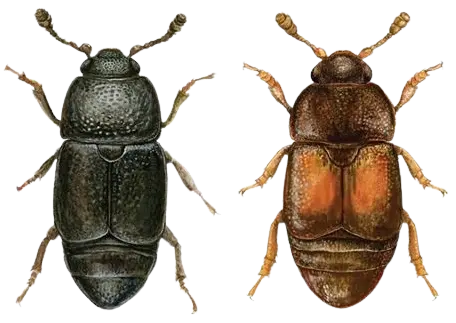
1mm
Oak Wilt Control
If you have an infected tree and no proactive management is implemented for oak wilt treatment, then the fungus will continue to spread unabated and eventually kill nearly every susceptible oak tree on your property, your neighbors, and beyond. Oak wilt can be managed with a variety of strategies that prevent new infection centers and limit the expansion of existing infection centers. A good management program for oak wilt will include all of the following strategies for combating the disease.
Do Not Transport Infected Wood
Cutting up trees infected by oak wilt disease for lumber, firewood or tree trimming and transporting the infected wood to new areas could transport the fungus to infect and kill trees in these areas. Do not transport infected wood from oak wilt killed trees.
Avoid Injuring Healthy Trees
Freshly wounded trees that are growing outside of existing oak wilt centers can be visited by beetles transporting spores of the fungus. Because open wounds create avenues for infection, damage to trees from construction, power line trimming, pruning, vandalism or storms may lead to new infection centers. For oak wilt disease prevention it is very important to avoid injury to oaks during favorable conditions for infection (cutting limbs or removing bark). According to the USDA, in the northern USA these conditions occur in spring and summer, when spore mats are present and the beetles are flying.
If construction activity, tree removal, or pruning is unavoidable, or if storms injure oak trees during the critical period, the wounds should be immediately treated with a commercial tree paint or wound dressing. If whole trees are removed during the critical period, the stumps should also be treated with tree paint. It is very important that the fresh wounds be treated immediately (within seconds!) because the insects that carry spores of the pathogen are often attracted to these wounds right away.
Controlling Existing Infection Centers
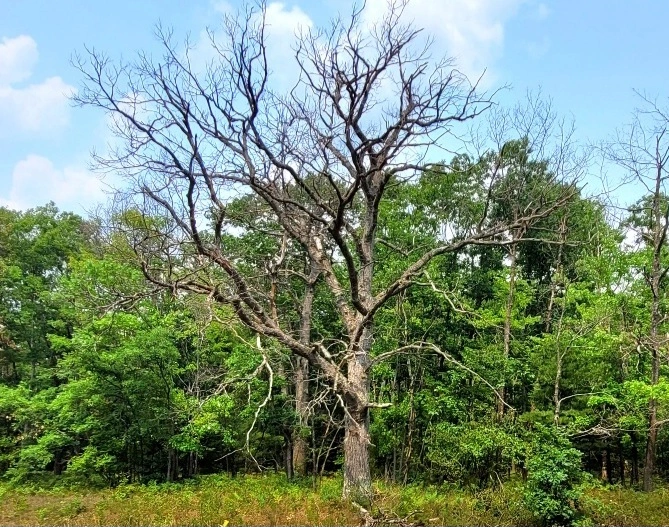
Physical Root Disruption
Interconnected root systems can be disrupted with a backhoe, trencher, vibratory plow or other equipment. By this method the equipment is used to cut roots to a depth of at least 4-1/2 feet along a boundary line beyond which there are only healthy oak trees unaffected by oak wilt. Disrupting the connections between the roots of infected and healthy trees limits the spread of oak wilt and is an effective control measure. Infected trees and their roots will usually die before root grafts can be reestablished. The oak wilt fungus reportedly does not survive in the root systems of dead trees for more than a few years.
Trenching can be effective for inhibiting expansion of oak wilt disease by root graft beyond a specific trench boundary. It does not protect the healthy trees from infection through above ground tree wounds by the sap beetles. Trenching may not be a practical solution in urban or developed areas, on rocky or steep terrain, or in very densely wooded areas. In addition there are cost and aesthetic disruption considerations with trenching.
Oak Wilt Treatment
Healthy oak trees can be treated using the fungicide Propiconazole 14.3 to prevent lethal infection by oak wilt disease. This is easily conducted using Chemjet® Tree Injectors to inject the fungicide into small drilled holes at multiple locations around the base of the tree. The chemical is then carried throughout the tree, from up to the leaves down to the roots, effectively protecting the tree from lethal infection of oak wilt disease.
The literature indicates a single injection treatment can protect oaks from developing symptoms for 2 years. However fungicide injection will generally not save oaks that are already visibly infected (i.e. leaves falling off). Treatment should be repeated every two years following the initial injection. Injections must be conducted while there are green leaves on the tree signifying the sap is flowing.
Injection Procedure for Oak Wilt Disease
Adapted from the Chemjet® manufacturer suggested procedure. You can inject at the root flare just above the ground, or at some point up the trunk that is easier to reach.
- Confirm with a qualified Arborist, or Biologist that this procedure is appropriate for your tree. You may not have an oak wilt risk or there may be other circumstances that would cause this procedure to be inappropriate. Also there is a risk that this procedure may harm your tree, or that your tree is already diseased and the chemical injection will be of no benefit.
- Only inject trees that have green leaves indicating there is transpiration and sap circulation.
- In southern states try to inject trees after a period of rain or after substantial watering.
- Follow personal protection recommendations from the treatment chemical label. This would generally include wearing rubber gloves and safety goggles during all mixing, injection and cleanup work.
- Disinfect Chemjet® injector and drill bit by washing and scrubbing in diluted bleach solution or Lysol disinfectant solution. Pull disinfectant solution through the nozzle filling the injector several times. Rinse inside and out with clean water.
- Prepare the fungicide injections per the instructions on the label from the chemical you are using. From the Quali-Pro Propiconazole 14.3 label, the standard dose is just over 3-inch injection spacing around the circumference of the tree using Chemjet Tree Injectors filled with solution of 50% propiconazole 14.3 mixed with 50% water by volume. Different doses or injection spacing intervals could be accomplished by adjusting the water dilution rate
- Drill the first three holes at three inch intervals around tree at a 45 degree angle downward no more than 1.25 inch deep. Only use a 11/64 drill bit. Drilling more than three holes may heat up the bit and scorch the wood which will inhibit injection.
- Pull the chemical mix into the injector until full at 20 ml and lock the handle back while twisting.
- Insert into recently drilled hole. Push into place and seal (don’t twist because the nozzle may break).
- Using both hands, hold the Chemjet® in place and then twist and release the red plunger handle so that injection begins. If there is leakage push the nozzle in harder to seal. Repeat for remaining two holes.
- After all chemical is in tree, pull injector straight out of hole. If chemical starts oozing back out of open hole, replace Chemjet® and leave there for another half hour or use a plug.
- Repeat with three more holes, going around tree.
- If an injector is taking chemical slowly, leave it in place. It could take up to 24 hours.
- IMPORTANT: Disinfect drill bit and all Chemjets (inside and out) before using on any other tree per step 6. Disinfect your hands and put on new rubber gloves to avoid potential for transferring diseases to next tree.
- Take Care of your Chemjet Tree Injectors after the work is done (or during long term work at least once per week) so they keep working smoothly by disassembling, washing all parts with hot soapy water, rinse and air dry, then lubricate the nozzle barrel and rubber plunger washer with silicone lube or vegetable oil before reassembly.
Here is a testimonial from a customer who used chemjet tree injectors to treat a large number of trees on his property for oak wilt: Oak Wilt Treatment Testimonial
Here is a video: Injecting for Oak Wilt
Get Chemjet Tree Injectors online here: chemjettreeinjector.com/products/
Other Treatments and Info
- Oak Wilt Prevention and Treatment
- Save Your Trees from Oak Wilt
- Microinjection to Protect Trees From Oak Wilt
- Emerald Ash Borer Treatment
- Dutch Elm Disease
- Pine Bark Beetle Injection Treatment
- Sudden Oak Death
- Hemlock Woolly Adelgid Treatment
- Asian Longhorned Beetle Treatment
- Caterpillars, Beetles, Borers
- Orchard Crops Treatment
- Plugs for Tree Injection Holes
- Chemjet Tips and Ideas
